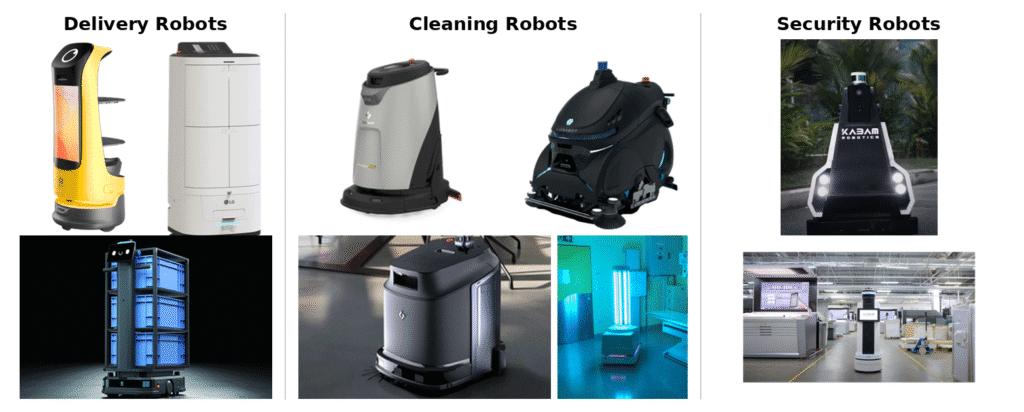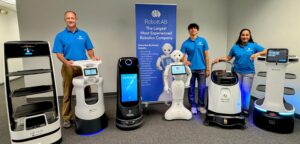Why Smart Businesses Are Turning to Service Robots
By RobotLAB Delaware Valley
The Labor Problem No One Can Ignore
Walk into almost any business today; a restaurant, hotel, warehouse or senior care center, and you’ll likely hear the same story: “We can’t find enough workers.”
This isn’t just a temporary issue. The workforce is shrinking in many industries, and customer expectations keep rising. Companies need to get more done, with fewer hands.
That’s where service robots come in.
What Are Service Robots?
Think of a service robot as a helpful assistant. It doesn’t look like a sci-fi machine. Most are simple, sturdy and built to do one thing, and they do it well.
For example:
- Some carry food to tables in busy restaurants.
- Others clean floors in hotels, hospitals, or warehouses.
- Some greet guests and give directions in malls or airports.
- Others patrol buildings and alert staff to safety issues.
They aren’t here to take over. They’re here to work alongside people, taking care of repetitive or physical tasks so staff can focus on more meaningful work.
Why Use Robots Now?
Service robots aren’t new. But today’s versions are smarter, safer and more useful than ever. That’s because of recent advances in:
- Sensors: Robots can now see and avoid people and obstacles
- AI: They learn from their environment and make better decisions
- Battery Life: Many robots can work for hours without charging
- Software: Robots now fit smoothly into business operations
All of this makes robots practical and affordable for regular businesses, not just big tech companies.
Four Key Areas Where Robots Help
- Cleaning
Robots can vacuum, mop, scrub, or disinfect large areas without supervision. They work at night or during the day, with no complaints or sick days. - Delivery
Need to move food, mail, or supplies? Robots can travel across long hallways, between floors, or even outdoors, reducing strain on human staff. - Customer Service
Some robots help guide guests, answer questions, or even entertain. They’re especially helpful in places with high foot traffic or multiple languages. - Security
Robots can patrol inside or outside, using cameras and sensors to monitor for unusual activity. Some even have lights and alarms to deter problems before they happen.

Case Study Snapshots: What’s Working
Let’s look at a few real-world examples.
🏨 Hilton Atlanta
The hotel needed to clean 30 floors every day, it but didn’t have enough staff. Vacuuming alone took hours.
Solution: Robots now handle hallway cleaning, saving staff time for guest rooms and improving consistency.
🎳 Area 254 Family Center
This entertainment center had staff walking miles every day just to deliver food.
Solution: Delivery robots now bring food directly to tables, summoned by staff using smartwatches and QR codes.
🏦 U.S. Bank Mailroom
Managers were spending hours delivering mail around a massive office space.
Solution: Six delivery robots handle drop-offs and pickups, freeing leadership to focus on higher-value work.
🧓 Senior Living Facility
Frequent delays in meal service and cleaning led to complaints.
Solution: Robots now deliver food and clean common areas, improving satisfaction and reducing overtime.
Do Robots Take Jobs?
This is a fair question, and the answer is important.
Robots don’t replace people. They handle jobs that are repetitive, physically tiring or hard to fill. This allows businesses to:
- Reduce burnout
- Improve job satisfaction
- Focus human energy on customer service, strategy, and care
In many places, robots have actually helped reduce staff turnover because employees are less stressed and more supported.
Understanding the ROI (Return on Investment)
Adding robots can seem like a big step, but many businesses see a return quickly.
Benefits include:
- Lower costs (less overtime, fewer temp hires)
- Faster service
- Better customer satisfaction
- More consistent results
Most importantly, businesses gain stability in their operations — something that’s hard to find in a tight labor market.
How to Explore This For Your Business
Not every business needs a robot — but many could benefit from even one.
Here’s how to start thinking about it:
- Where do you struggle to find or keep staff?
- What tasks feel repetitive or physically tiring?
- Where could automation free up time for better service?
You don’t need to be a tech expert. The best robots today are designed for ease of use, even by people with no tech background.
The Future of Work Is Here
Businesses that embrace smart tools — like service robots — aren’t replacing people. They’re reimagining how work gets done.
In the same way that computers made paperwork faster and email changed communication, robots are changing how we handle physical tasks. And just like those past innovations, it’s not about replacing humans — it’s about helping them do more.
Ready to Transform Your Business?
Service robots are helping businesses solve labor challenges right now. Don’t let staffing issues hold you back.
🎓 Free consultations — learn what’s possible
🤖 pilot program — test a robot in your own space
🧠 Simple training — no tech knowledge required
Call us at 610-427-2445
Visit robotlab.com/delawarevalley
Serving warehouses, commercial spaces, restaurants, healthcare, hospitality, education and more.

